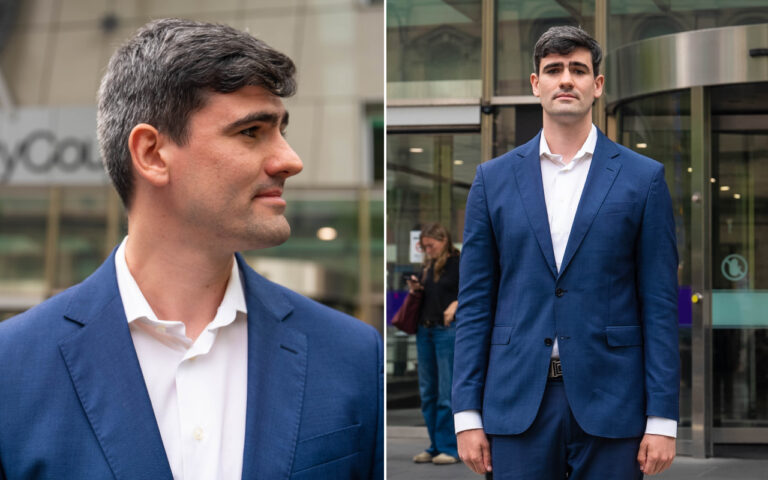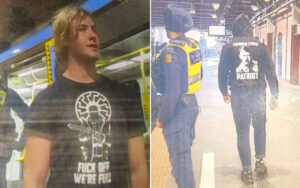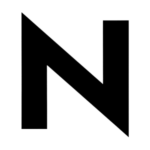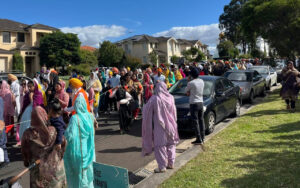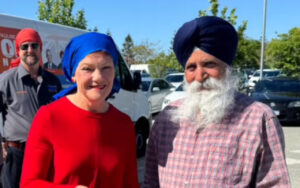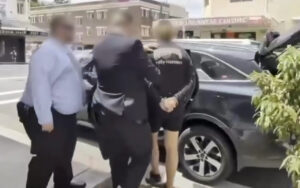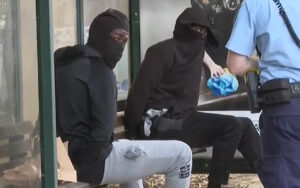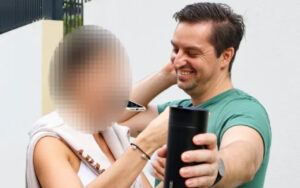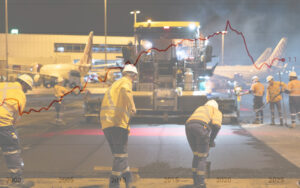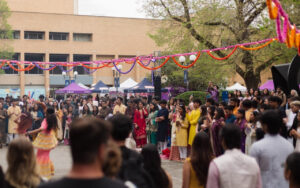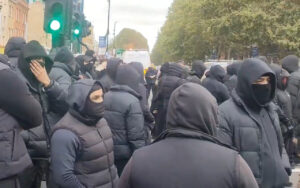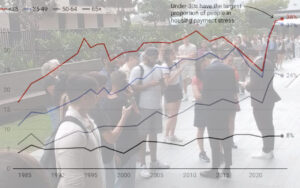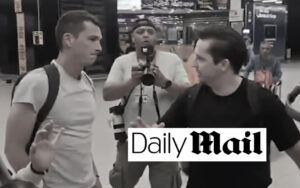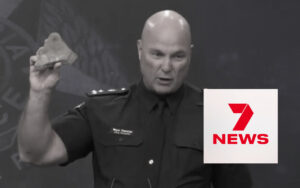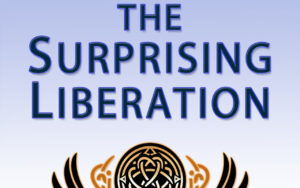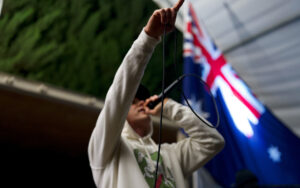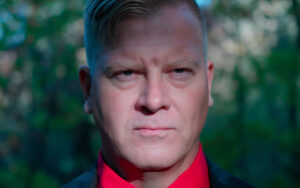A nationalist activist has challenged Victoria’s controversial Nazi salute laws while appealing his jail sentence and conviction for allegedly performing the gesture in a case with massive implications for political freedom in Australia.
National Socialist Network leader Jacob Hersant, 26, argued in the County Court in Melbourne this week that he did not perform the salute, and the laws themselves were invalid as they violated the implied right of all Australians to political communication under the Constitution.
Mr Hersant, who is also acting leader of political organisation White Australia, was sentenced to one month’s imprisonment in November last year after being found guilty of making the salute outside the same court in October 2023, but was released on bail after launching an appeal.
Judge Simon Moglia told the court on Wednesday he would hand down his ruling at a later date after hearing three days of submissions from Mr Hersant’s lawyer Timothy Smartt, the prosecution, and counsel representing the Victorian Attorney-General.
The court heard on Monday that charges were laid after a 9News cameraman made a statement to police about footage he filmed of Mr Hersant and fellow activist Thomas Sewell on the day of their sentencing over a clash with far-left activists during a camping trip in 2021.
A nine-minute video played to the court showed Mr Hersant and Mr Sewell speaking to reporters outside the court before Mr Hersant raised his arm partway, lowered it again and said: “Oh, nearly did it, it’s illegal now isn’t it?”
The Crown prosecutor argued on Tuesday that even though Mr Hersant did not perform a “perfect” salute, the arm movement still violated the then-six-day-old ban because “the same harm is caused” by any gesture that could be mistaken for a Nazi salute.
Expert witness for the prosecution Dr Robert Loeffel, a high school teacher with a PhD in history from the University of NSW, earlier told the court that a Nazi salute required the arm to be raised to a height of 135 degrees, with fingers outstretched, palm showing and “tension and rigidity throughout the body indicative of concentration and solemnity”, and that it was usually accompanied by the phrase “Heil Hitler”, “Heil”, or “Sieg”.
The prosecutor told the court that in order to stop people avoiding the law by making minor changes to the salute the legislation had to cover gestures that “fall short but are close enough in performance”, and that although Mr Hersant’s arm didn’t reach 135 degrees, he said “Heil Hitler” and “Australia for the White man” shortly afterwards.
He also argued that Mr Hersant intentionally made the salute because “if he went as far as he did then it means he intended to salute as far as he did”.
But Mr Smartt told the court that his client had not performed a Nazi salute as defined by Dr Loeffel, nor had he intended to perform one, saying that a person dressed as a Nazi hailing a taxi could be found guilty of violating the salute ban if intentionality could be that easily linked to any gesture that resembled a salute.
Mr Smartt argued that the video supported three possible interpretations, all of which favoured his client, telling the court that Mr Hersant either genuinely withdrew from the salute when he remembered it was illegal and therefore did not perform it, that he was pretending to be about to perform the salute, or that he intentionally performed a gesture that was not a salute in order to mock the then-new laws.
On Monday the court heard from another expert witness for the prosecution, Professor Katherine Gelber, a University of Queensland political scientist who testified that the Nazi salute was a “virulent act of hate speech that is extremely harmful”.
She was extensively cross-examined by Mr Smartt about a study she relied on for many of her claims for which she interviewed 101 “members of indigenous and minority ethnic communities” about their “lived experiences” with so-called hate speech.
During the exchange Mr Smartt repeatedly asked Dr Gelber for empirical evidence that the Nazi salute caused harm to minority groups, and Dr Gelber repeatedly responded that it caused harm because it was a form of hate speech.
“Have you cited an empirical study showing the Nazi salute causes harm?” asked Mr Smartt at one point during the cross-examination.
“Yes, because the Nazi salute is hate speech,” Dr Gelber replied.
“There is no source that shows the salute causes harm beyond offense or insult, you have never cited a study,” Mr Smartt said, to which Dr Gelber responded that it was an “incontestable position” that the Nazi salute was hate speech.
The counsel for the Attorney-General told the hearing that Victoria’s anti-vilification laws and Nazi symbols and salute bans had either no or a “very small” impact on the implied right to political communication, arguing they “set boundaries for political debate” and “enhanced political communication” by preventing “profound harms suffered by minorities”.
“Hate speech undermines participation by stifling participation, making targeted groups feel intimidated or apprehension about expressing their views in public, people are more likely to take part in public life if they do not feel intimidated or threatened,” she told the court.
She further argued that the Nazi salute laws did not ban Nazi ideology, which she said was in itself “far outside the scope of implied freedom” as it was “incompatible with representative and responsible government”, said the salute was “inextricably linked” to genocide, and told the court that asking for proof of harms done by the gesture would be “re-traumatising” for victims.
Mr Smartt told the court that the Nazi salute could have a range of meanings, but that even on its strongest meaning there was no evidence that it caused harm.
“What harm are we preventing and how are we doing it? No one has told the court this, we just get this very Delphic murmuring that the Nazi salute gives all this harm without any evidence for it, there’s no evidence of any type of how it causes harm,” he said.
He warned that the Nazi salute ban was “breaking new ground” and “takes us down a dark path, that applied in the aggregate, we might not return from”.
“This would be the first offence that targets a political gesture and bans it, this stands to set precedent that the government can do that, which has troubling implications for other gestures and symbols that could be banned,” he told the court.
Mr Smartt then pushed back at the claims that members of minority groups might be “triggered” by seeing a Nazi salute, and told the court there was no evidence that hate speech caused people to disengage with democracy.
“Does hate speech cause minorities to leave public debate or enter it? There’s no evidence, it’s not a factual matter, it’s wrong on a matter of principle and wrong to get into it,’ he told the court.
Mr Smartt went on to ask the court whether the Nazi salute laws were a “way of getting offensive speech banned” as “every person who claims offence, claims harm”.
“What does the law do in this case? It bans Nazi gestures, it doesn’t ban KKK flags, it doesn’t ban other extremely charged gestures, and it’s so far reaching it applies to other Nazi gestures that haven’t been contemplated or defined,” he told the court.
Mr Smartt then compared the case to Prime Minister Robert Menzies’ 1951 banning of the Communist Party, which was overturned by the High Court.
“Testing the theory of harm by reference to the Communist Party case shows where its flaws are. The great achievement of the case was to expose that kind of reasoning for what it is – reasoning that confuses offence and projects harm into the future without an adequate factual basis,” he said.
“Can we distinguish the cases? The Communist Party case was even more charged and profound. Think about the dark path we would go down by banning political gestures.”
Judge Moglia extended Mr Hersant’s bail until December 19, but said he would hand down his decision at a hearing on a yet to be determined date before then.
Header image: Left, right, Jacob Hersant outside County Court.
